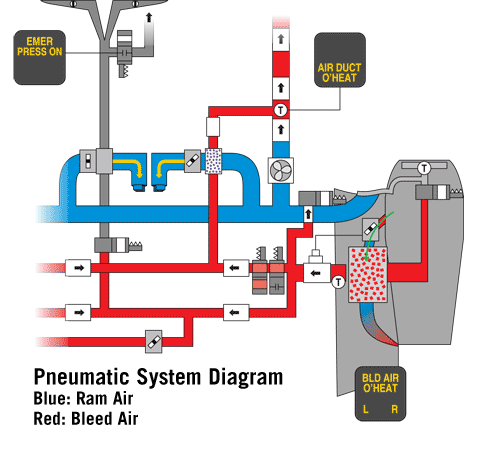System synopsis: Bleed air malfunctions
Knowing what to do when hot bleed air becomes too hot

Engine bleed air systems can vary widely in design and operation from one airplane type to another, but they all perform the same basic group of functions. Bleed air pressurizes the cabin, heats and cools the cabin, provides heat for ice-protection systems, and even inflates door seals. Here, in a brutally brief nutshell, is how bleed air systems work:
March 2011 AOPA Pilot Turbine Edition
- Turbine Intro from Tom Haines, Editor in Chief
- Mission Ready: American Eurocopter's AStar
- Mentoring Matters: The Need for Less Speed
- System Synopsis: Bleed Air Malfunctions
- Ronnie Morgan: Fear Is No Longer a Factor
- Logbook Entry: Commentary
Hot air from engine compressor sections (usually the third compressor stage, dubbed P3 air) is tapped, then sent to an air-to-air precooler (think of a car radiator) for cooling. Its temperature is regulated by a flow valve that introduces ram air. How hot is the engine air before it’s regulated? A nominal temperature would be above 500 degrees Fahrenheit. After passing through the precooler, bleed air temperature drops to, say, 450 degrees F.
This hot air is routed to an environmental control unit for further cooling. Obviously, 400-plus-degree air is way too hot for cabin heat! Some airplanes use air cycle machines (ACMs) to make the incoming air manageable; ACMs use compression and expansion turbines to regulate air temperature. Vapor cycle systems use refrigerant gas to do the job.
Other bleed air lines are routed to leading edge or windshield ice-protection components. Flow control check valves keep the air moving in the proper direction, and the pilot can select (in twins) either left, right, or both engines as bleed air sources; normally, bleed air from both engines is used. There’s also a temperature selector to make the cabin warmer or cooler.
Overheats
As you might suspect, a main concern is overheating of the bleed air lines and ducts. A break in a bleed air line, or an overheat caused by a malfunctioning ACM or vapor cycle system, can be serious indeed. Fire, melting of components, and smoke and noxious fumes in the cabin can result.
To warn against this, caution and warning annunciator panels light up should an overheat occur. Consult the checklist for your specific airplane, but most times a bleed air overheat is considered an abnormal condition, so that means an amber warning light. To use the Cessna Citation CJ3 as an example, two annunciators address bleed air problems. Let’s see what the checklist says for each type of overheat.
Bleed air overheat
The CJ3’s BLD AIR O’HEAT L R lights up when the bleed air leaving the respective engine pylon-mounted air-to-air precooler rises above 560 degrees F. This could be caused by a break in a bleed air line or, more likely, when flying with high engine power settings and bleed-air-powered ice protection components on.
The checklist has but two steps, and carries some big implications. The first step is to reduce power to the side with the overheating bleed air—if practical. Of course, that also means retrimming the airplane. Step two is to turn off the engine fan synchronizer knob—the synchronizer is meant to synchronize engine speeds at normal power settings, not when there’s a gross mismatch in power output.
Cessna says to maintain better than 75-percent N 2 on the engine running at reduced power if wing or engine nacelle anti-ice is in use. This should be enough to provide a safe flow of air hot enough to prevent ice from forming. But what if you’re in heavy icing, and the anti-ice panels can’t do their jobs properly? A diversion to an alternate airport may be in order. That means descending, and that means reducing power. Here’s where things can get sticky. Below 75-percent N2, the bleed air isn’t hot enough to fight ice accretions.
Air duct overheats
Another amber light, the AIR DUCT O’HEAT annunciator lights up when the ship’s environmental system (heating and air conditioning) ductwork sensors detect that they’re becoming hotter than normal. Typically, this means that the temperature control unit has gone haywire, and too much hot air is flowing into the cabin and/or pressurization lines.
To lower the temperature, the checklist says to reset the temperature circuit breakers (the environmental system is electrically powered), then select a lower temperature. If this doesn’t extinguish the overheat light, then rotate the temperature selector knob to the MANUAL position, then use the MANUAL HOT COLD toggle switch to select a maximum-cold situation. That means holding down the toggle switch for 30 seconds.
Light still on? Then select either left or right engine bleed air, and try to control temperature with the respective thrust lever. Oh, and don’t forget to turn off the engine synchronization.
Light still on? Now the drill calls for engaging an emergency air source, then descending. Once at a breathable altitude, select FRESH AIR with the air source knob (this will depressurize the cabin) and make a precautionary landing.
Not all bleed air systems are alike, so be sure you understand the system you fly. One thing remains the same, however: Bleed air overheats can be easy to solve, but if you’re having a lousy day they can cause big trouble rapidly. Keep that checklist handy! —TAH


